When I wrote about the classes (post 1, post 2, post 3) with Jorge and Maria Dispari I forgot to mention another conversation with a leader I dance with sometimes, who'd taken some of the classes too.
I didn't go to the closing milonga because I was pretty much too tired to speak. But he did, and he got to dance one track with Maria.
Hedgehog: What was it like?
Leader: It was amazing. Like dancing with a rollerball.
Hedgehog: What's a rollerball?
Leader: Errr ... like a hovercraft.
She told him to keep it really really simple and not worry. It was magic. It was so easy.
He couldn't really explain to me what it was she did to make it so. But I felt obscurely encouraged to hear from someone I know, and whose dancing I know, what a difference the follower can really make.
I don't know what it is specifically Maria does that makes it seem so magical, but at least I was reminded that it matters. I may never be Maria (or a hovercraft), but at least there's some point in trying to improve.
Wednesday 30 July 2008
On Dancing with Maria Dispari
Posted by
msHedgehog
at
23:25
3
comments
![]()
![]()
Labels: argentine tango, technique
Tuesday 29 July 2008
El Porteñito @ the Bedford
I wanted a change this week and went to a milonga people had recommended to me. It's called El Porteñito and it's every other Sunday (mostly), at the Bedford pub, in Balham. It's organised by Leo Fandango and Bridget Mayer. Don't be too alarmed by the studio photos under 'shows' - in real life Leo is very nice and looks nothing like a Vulcan in the mating season. Really. At the time of writing they also do classes, currently on Mondays and Fridays, and a milonga on Fridays at a different location, see website.
The class: I was too late for the class, it's too far away for me. The room would be nice for a class, though.
Layout and atmosphere: Good sized rectangular room, nicely lit, chairs around the walls with tables at intervals, a DJ desk in the far corner, and a bit of a stage for the band across the end. When I came in, the band had just been introduced. Almost all the seats were occupied, the floor was nearly empty, and I had to hover for a while feeling embarrassed and exposed before people got up to dance and I found somewhere to perch. Next time, I'd stop in the downstairs bar to change my shoes. The tables are round, and big enough to give you some protection and make you feel as though you're not actually sitting on the dancefloor itself. Attractive silver tablecloths, large windows with dark curtains. The room was airy and quite cool on a very warm evening promising thunder. I was told that it was a bit empty, but I thought there were plenty of people there, so it's a popular place. The crowd was a fairly good mix of ages. The floor is good, smooth, and nice to dance on, if a little bit slippery - enough to be alarming with any leader who throws you around. If you want a rest, there's scope for retreating to the downstairs bar, but if you're in the room at all, standing on the dancefloor or sitting on the edge of it are your only options. The atmosphere generally struck me as friendly and I saw quite a few people I knew.
Hospitality: good. It's a large, pleasant, comfortable pub. You can eat there if you're not too late, from a menu with modest aspirations to gastronomy. My G&T and a pint of cold tap water with ice were served with a smile and cost £3.60, I think. The loos are about as clean as you'd expect from a large pub, the doors a bit rickety, but well supplied and working. I don't think there was anywhere to hang your coat upstairs, and as it was so hot I hardly had anything with me. But there was a room off to one side through the main room that could have been used to put things down - tonight the band were using it, though. There is also quite a lot of scope to tuck things under tables and hang them on chairs, and there are broad ledges at one end of the room with space for a lot of people's kit.
Anyone or anything interesting that turned up or happened: There was live music for most of the evening, with Carlos Quilici on bandoneón (and percussion - sometimes using the instrument, sometimes the floor) and Javier Fioramonti on guitar. They played traditional tangos, milongas, and their own compositions including a sort of milonga-candombe, with cheerfulness and verve. They had some CDs for sale. Carlos has a website, I can't find one for Javier.
What I thought of the DJing: a lot of the time it was live, and the band played what they felt inclined. They tended to do couple of tangos and one milonga, but Carlos always announced the milonga so you could opt out if you weren't ready (I hate getting milonga sprung on me unexpectedly when I'm dancing with someone who can't dance milonga). Their variations of rhythm are probably enough to throw you if you're not used to live music or you need a very strong, explicit beat, but I didn't feel there was anything eccentric or inconsiderate there. When they weren't playing, Bridget DJ'd, playing a little bit of modern as well as traditional, with quite a few milongas. The sound system was fine, I could hear everything properly from everywhere.
Getting in: it was £8 with live music, a bargain.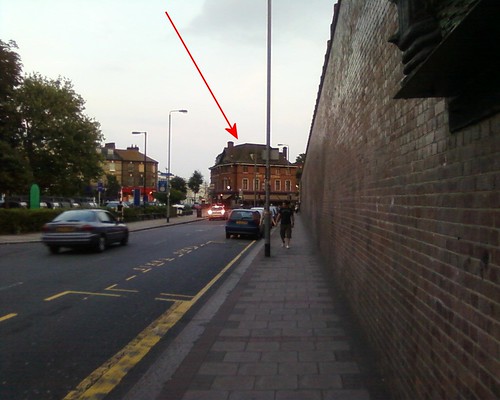 Getting there and getting home: from Balham tube, take the exit for the train station, opposite Barclays, and walk to your right, past a couple of shops and along the long brick wall (pictured). You'll be able to see the pub when you get past the shops. Watch out for the awkward, dangerous pedestrian crossing at the end. When you get to the pub, there's no clue at all that there's tango anywhere. Go in the main entrance and turn right, go through the door where the tapestry is, and right again, out into a little porch, where you do a u-turn and go up the stairs. The downstairs bar is roomy and pleasant, you might stop there to change your shoes. It finishes at eleven, so you can reverse the process to get home, as long as you don't dawdle - remember it's Sunday.
Getting there and getting home: from Balham tube, take the exit for the train station, opposite Barclays, and walk to your right, past a couple of shops and along the long brick wall (pictured). You'll be able to see the pub when you get past the shops. Watch out for the awkward, dangerous pedestrian crossing at the end. When you get to the pub, there's no clue at all that there's tango anywhere. Go in the main entrance and turn right, go through the door where the tapestry is, and right again, out into a little porch, where you do a u-turn and go up the stairs. The downstairs bar is roomy and pleasant, you might stop there to change your shoes. It finishes at eleven, so you can reverse the process to get home, as long as you don't dawdle - remember it's Sunday.
The website: Does the job much better than most. It's well organised, easy to navigate, tells you what's on, when, where, how much it is to get in, and what events you can and can't bring your own drinks to. Leo's little article about what he thinks it's all about is worth a read.
How it went: Quite well. Even on a thin night, there were a good number of people there I wanted to or was willing to dance with, enough of whom felt the same about me. I'd probably go there regularly, if it wasn't an hour away, and on Sunday. As it is, it's high on my list for Sundays when it's a bank holiday or I otherwise have Monday off work.
Posted by
msHedgehog
at
19:07
1 comments
![]()
![]()
Labels: argentine tango, London milonga reviews
Monday 28 July 2008
A Tenor Masterclass
This is one of my YouTube favourites. It's a clip from a masterclass by Placido Domingo, in the early eighties. I think it's a brilliant nine-minute tutorial on what "musicality" in a performance actually means. The word isn't mentioned; that's just my opinion.
My favourite bit is from about 03:30, when Domingo first illustrates a point about the word "cielo", then goes straight on with his verbal advice, "when is coming the word, cielo," without giving the audience time to recover from what he's just done. This causes such discomfort that they laugh, forcing a pause. The student's reaction is funny, but watch the pianist, too.
There are some related clips that well worth watching if you click through - I think this one is very instructive. It would be nice if these clips were available commercially, but I doubt they are.
Posted by
msHedgehog
at
21:18
0
comments
![]()
![]()
Labels: music, musicality, videos
My Commute
For Tangobaby - with my cheap, elderly digicam.
A platform ...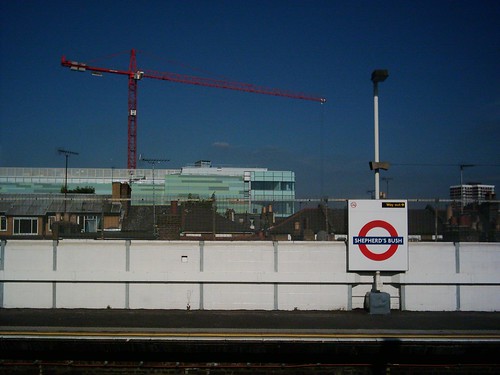
A view from the train ...
These are round the back of Television Centre, just down the road from my office. If you've ever watched John Simpson bleeding for his viewers on BBC News, it probably came through one of these. I've often wondered if they really have to be white all over - if they can have a boring little logo, couldn't they be painted to look like giant daisies? I asked someone who knows and he said it probably helps, technically, that they're mostly white.
The awesome roof of St. Pancras International, with a statue of Betjeman, the poet, visible on the bridge.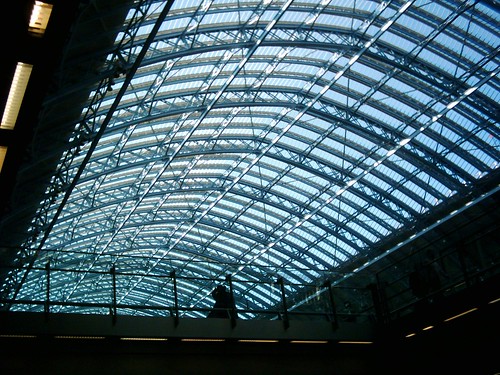
If Paddington is the Valhalla of trains, this is Freya's hall of clouds. It was recently restored and repainted in the original colour. I don't need to go upstairs here when changing between my usual trains, but it makes a nice picture. If they have to close the underground station for overcrowding, you can walk to Euston, or for about the same amount of time you can come up here and get a reasonable crêpe and a cup of tea and by the time you've finished it will probably be open again.
Here's Sir John Betjeman:
The statue is here because he liked the place and wanted it to be properly restored. Notice the gothic arches behind him; the eminent Victorian who designed this and the vast steel roof saw no cause to change the style because of he changed technology; apart from the inspired idea of painting the roof sky-blue.
The clock.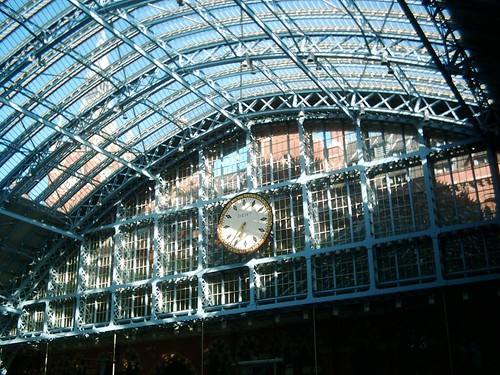
Nearly home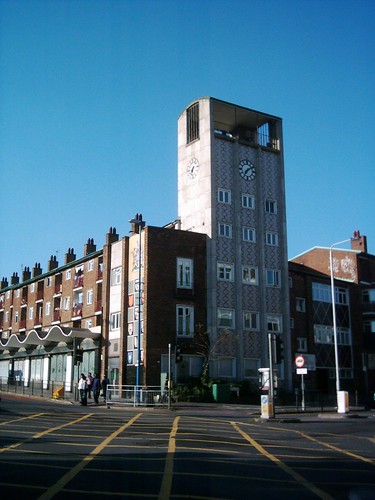
Posted by
msHedgehog
at
17:37
3
comments
![]()
![]()
Labels: observations, Photographs
Sunday 27 July 2008
Argentina in the UK
On Thursday I was at a very curious event. I was there as the guest of a friend who organises a milonga. We'd been invited to the Argentine Residence, for a book launch. It turned out when we got there that it was also a small leaving party because the Ambassador is going to retire. It looked as though they'd invited more or less everyone they could think of, and were slightly startled at how many had turned up.
The Residence is a house on the corner of Belgrave square, so of course a fine house, of a kind very different from what any of us would normally enter, with marble reliefs in the octagonal entrance hall, squared columns, gilt details, chaises longues, and beautiful windows and balconies where, of course, people hide to smoke. It's also (apart from the gilt) painted entirely magnolia.
The book seems to have been the Ambassador's idea. He gave a little speech which was exactly what I'd expect from a retiring diplomat; graceful, neither too long nor too short, thanking the sponsors and volunteers, expressing his surprise at getting money from the Ministry, sketching the inevitable last-minute panic, referring to the book as his child, and telling us we would all be presented with copies on our way out. We were then served canapés, empañadas, which I find are a miniature Cornish Pasty with crunchy pastry, and a very soft, likeable red wine.
It's really more of a brochure than a book. It's written in an elegant, slightly erroneous English, and reminds me of the kind of thing big international companies give to all the new employees when they take over a smaller one. It has just the same vulnerable crispness, the identical freshly-printed smell of ammonia, and the same solemn, careful willingness to please. The cover is pale blue, and the title and back-cover blurb are in reflective silver; allusive and patriotic, but rather hard to read. There are pages and headings where they couldn't refrain from printing in white on a sky-blue background, but most of it is kinder to your eyes.
It starts with a historical chapter, interesting and new to me. I had noticed the blue plaque of José de San Martín on a house near Regent's park, but I had never heard of Don Juan Manuel de Rosas, who it seems was largely responsible for the existence of Argentina, and who lived the last twenty years of his eighty-three on a farm near Southampton, always wearing a poncho and silver spurs, planting espinillos in his garden (what are they? a cactus?), and personally lassooing his horse. He died in 1877, admired by all.
As though he could be topped, they now turn to double-page portraits - a page of photo, a page of text - of interesting Argentinians now or recently living here. Aside from"notorious" not being the word they wanted, this works very well. In case you're interested, the 'characters' to look out for are:
César Milstein - Nobel Prize winner (for finding a way of making monoclonal antibodies)
Mario Blejer - economist (advisor to the Governer of the Bank of England)
Agustín Blanco-Bazàn - international lawyer (also contributes to the book with an interesting two-page spread about the war)
Carlos Brebbia - engineer (founded the Wessex Institute of Technology and edits some engineering journals)
Dame Julia Polak - professor of medicine (much cited on tissue engineering)
Bautista Heguy - polo player
Marcelo Loffreda - rugby coach (oh yes we've heard of him, now at Leicester Tigers)
Diego Jacquet - head chef at the Zetter hotel (never heard of him or it, but I'm no foodie, I'll ask my sister)
Elena Roger - singer, actress (previously Evita, Edith Piaf next)
Marianela Núñez - principal ballerina at the Royal Ballet
Marcelo Álvarez - tenor (I may have heard of him but it's not quite clear why he's in this as I don't think he's based here)
Gabriela Salgado - curator of Public Programs at Tate Modern
Next is a a cultural chapter with a picture of Miguel Angel Zotto hiding underneath some chiaroscuro and a hat, and discourses on arts, films, football, and shopping; nothing on rugby, which is a pity, as I think it's got promotional potential. They've certainly been my second team ever since the World Cup. They really were the best thing in it. Unless you're France.
After Blanco-Bazàn's two pages about the war, honoured with bright yellow paper, there follows an illustrated product guide, telling us where to get Argentine beef, dulce de leche, mate, Quichua arts and crafts, saddlery and polo accoutrements, agricultural machinery, and wine. My favourite bit of this is the rather beautiful technical drawing of the 'pneumatic monograin system', which I think is for planting seeds.
It concludes with some pages of charts about trade since 1900, which tell you a good deal more about the strange history of Argentina's economy than they do about this relationship in particular. Curiously, the charts for 'now' only cover merchandise. Maybe services and remittances - dancing teachers, rugby coaches, footballers and whatnot - are difficult to measure, or negligible in size. Or it could be that they don't show up because so many of them have Italian passports, with the automatic right to work here. But it doesn't seem to say so, and I wondered.
In the back are some pages of links, including ten milongas, one my friend's.
All in all, it's a funny thing, and destined no doubt for utter obscurity, but I just had to tell you about it because it's so clearly a labour of love. If you wanted a copy you could probably ask them, here.
I was told that the government of Argentina, which is a bit busy, hasn't yet got round to providing a new Ambassador. This means that the young gentlemen and ladies who work at the Residence will be partly left to their own devices for some months, and one who I have danced with once or twice has some ideas. Will he ever get away with it? Dunno.
Posted by
msHedgehog
at
15:00
6
comments
![]()
![]()
Labels: observations, outings
The Strap Wrangler
I have now heard from two independent sources the story of the tango dancer (male) who perfected the technique of undoing women's bra straps while dancing with them.
The act itself could be done, with sufficient skill. Certainly not without her noticing that it had happened; but perhaps, under favourable conditions, without her being absolutely certain you'd done it on purpose. I'm not convinced.
The person who told me this story tonight thought it had happened in Berlin; but could produce no witness, and freely agreed that the evidence was weak. The person who told me a year or so back that it had happened in London may have believed it was true, but was certainly mainly concerned with its being amusing.
I think the thing might be possible, up to a point, and is a somewhat obvious idea. I can imagine someone thinking "what would happen if ..," uttering the thought to a friend, and inadvertently starting a legend. I can also imagine that there were two men to whom it seemed both worth doing, and feasible. It could have happened twice, or happened not at all. It could have happened at a university.
So:
Had you ever heard this story before me telling you?
Who told you?
Where did that person think it had happened?
Was that person an actual witness?
Is it even possible, and how exactly do you know?
Can you now refrain from telling someone else?
Goodnight.
Posted by
msHedgehog
at
00:40
4
comments
![]()
![]()
Labels: argentine tango
Monday 21 July 2008
Not Much Tango
Sorry to my tango readers that there's not much tango here just at the moment. I haven't been in the right frame of mind.
A couple of weeks ago my elbow - which is rather small - got caught in the bit between the train door where it slides open, and the carriage wall on the Hammersmith and City line. It hurt a lot, and I felt very faint and wobbly, and had to be helped off the train (thank you, kind black lady with giant paper shopping bags and a nice voice) and written down as an Accident Report with my name, age, and address. But with eight hours wrapped in frozen peas and two days of one of those elasticated bandages, it was much better. It didn't swell up as I thought it would, and over the following week the weakness, discomfort and tinglyness worked their way down my arm and out of the tips of my fingers; I spent last Friday away from the computer, and now it's completely better.
I wish it were possible to put frozen peas on the bits of your soul that get caught in things. Knitting with my Mum, or friends, or even alone, is the nearest thing I have. But I am very careless at dealing with such injuries, and they tend to get worse, like a fast bowler's ankle.
Thinking about little technical things helps. These are on my list for now:
Not overstepping
Not overtwisting
Feel secure and centred
Put more energy through my upper body
Feel the 'Ornaments' falling into place - and don't think of them as just ornamental.
But I'm looking forward to my holidays.
Posted by
msHedgehog
at
23:38
3
comments
![]()
![]()
Labels: argentine tango, observations, technique
Wednesday 16 July 2008
What makes a face?
I was chatting with a friend about some drawings that he and I had (coincidentally) made, some time ago, of a statue from the Nereid Monument. My friend particularly admires the Cycladic Figures, which have a greater aesthetic appeal to him, but which he finds, strangely, more difficult to draw. The sheer technical virtuosity and physical presence of the nereid statues does it for me; and also I was there mainly to practice my figure drawing. But the cycladic ones are fascinating aesthetically, and in respect of the question of what the essentials really are that make a shape appear to be a human figure capable of carrying emotional force.
There are many other things in the museum which present that question - a prehistoric sculpture of lovers that was in the temporarily-displaced-objects-room behind the shop when I was last there, is a good example. How exactly do our brains tell that it represents a pair of lovers, or indeed anything else? I know it's obvious - but how does that work?
It's the same kind of question as I asked myself when I set myself the task of knitting a frog. I don't use patterns - I always design. What makes a frog recognisably frog-shaped? After a bit of musing I concluded that it was essentially two long legs, two short legs, webbed feet, and goggly eyes, probably reinforced by greenness. The Moomin was a slightly different question because Moomins are fictional and all the same shape, only distinguished by accessories. So I had to get it right; but nevertheless it was obvious to me what I had to get right. How did I know this? I have no idea.
More broadly, I suppose the tendency to detect personality in things that have a face or look somehow humanoid is a basic observed property of the human mind, and it's what gives us the power to domesticate animals, as well as to knit things other humans will perceive as having personality.
And it's remarkable how little is needed to convey the idea of a face. What would Picasso have made of the standard smiley? :) It's quite clear to everyone who turns their head that this is a face, :o) But why and how do we know that? :-O
Even wierd goggly stalk-eyed stripey textured bell-legged asymmetric birdlike toys we give to babies, recognisably have faces. But how do their odd arrangements of buttons and blobs amount to faces? They are instantly recongnisable to humans as faces, in the same way that a piece of red cotton wool on a stick is instantly recongisable to a robin as something to attack. (If you have one in your garden, you can easily try this. It won't work on American robins - different species).
At the moment I'm working on a Fair Isle tiger. Its face will simply be embroidered on one end.
Posted by
msHedgehog
at
23:01
3
comments
![]()
![]()
Labels: knitting and crochet, observations
Tuesday 15 July 2008
Knitting Circle Baby Blanket
 The puddock-baby - three weeks old and still looking all squishy-faced - belongs to a dear friend of mine who is also a regular knitting companion. There are several of us who go and knit together on Wednesday lunchtimes in a quiet spot near to all our offices. We feel deliciously subversive to be away from our screens and papers and engaged in productive, often creative labour. We chat about this and that, and help each other - and newbies are welcome - with any little technical issues and the interpretation of patterns.
The puddock-baby - three weeks old and still looking all squishy-faced - belongs to a dear friend of mine who is also a regular knitting companion. There are several of us who go and knit together on Wednesday lunchtimes in a quiet spot near to all our offices. We feel deliciously subversive to be away from our screens and papers and engaged in productive, often creative labour. We chat about this and that, and help each other - and newbies are welcome - with any little technical issues and the interpretation of patterns.
C is the first of our regulars to produce young. Of course babies are great fun to knit for - everything is so small, so cute, so simple. But rather than make lots of unnecessary objects, someone thought of making a joint effort.
So, one of us had the idea; four of us (including me) knitted a few squares each; I did the logistics and volunteered to crochet them together. The rules were that squares should be made of machine-washable wool, roughly 12cm square, and in any design and colour the maker felt inspired. Once I'd got enough squares, I laid them out in a pleasing arrangement of colours, discarded a couple of extra ones, and worked a crochet border around each of them in black. I laid them out again, tweaked the arrangement, then crocheted them together along the zigzags. At top right is what it looked like at that point.
Finally, after the little matter of working in an unreasonable number of ends for something so small, I washed it on wool cycle and pinned it out to a neatish rectangular shape. Together with compensation in the crochet and in the arrangement, that took care of the differences in size and squareness. 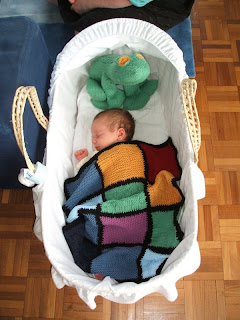
Posted by
msHedgehog
at
21:54
4
comments
![]()
![]()
Labels: knitting and crochet
Sunday 13 July 2008
A Frog or Puddock
 Here is the completed Puddock. He's a tiny bit older than his new owner, who he's going to meet today.
Here is the completed Puddock. He's a tiny bit older than his new owner, who he's going to meet today.
All animals are essentially tubes. I started behind the eyes, witha provisional cast on. I decreased and then increased to shape the neck, and closed the bottom. Then I put in most of the stuffing and picked up again at the start - his eyes are essentially just buttonholes, with the cables giving them a bit of shape. I stuffed him well and made a sort of sock toe for his face. Next I made four legs, two long and two short, grafted their toes and sewed them on. Lastly I made two crochet circles for his eyes, and sewed them in. Right, off we go.
Posted by
msHedgehog
at
13:00
5
comments
![]()
![]()
Labels: knitting and crochet
Wednesday 9 July 2008
iPod Tango
Not the iPod Tango I mentioned before, where one person seems to be listening to different music from everyone else. Here's the deal; two people wire themselves into one ipod, and they dance, in silence, for an audience of bemused commuters. This is what it looked like. The only sounds were the normal sounds of St. Pancras International, as you hear in the video. They include the long, low note of an arriving Eurostar. I don't know either of the dancers shown, but I thought I recognised both from milongas around London. If this is you, please comment - even if you prefer to stay nameless.
The marketing of this stunt inspired an overheated but interesting correspondence on Tango-UK. I should say that my thought, too, when first presented with the exploding-Yorkshire-plonkers connection, was "Yuk, that's a No, then." But I'm not criticising anyone else for taking part. They may not feel the same about it, and I think the judgement is more aesthetic than moral.
But none of that is relevant to the really quite interesting wackiness of the idea itself. I can see why you might want to do this in your own home, and perhaps it would be an ingenious approach to a practice session (splitters provided, along with mints?). But dancing for an audience, keeping the music to yourself?
I discussed it with someone this week who pointed out that, as people who already dance, we have a mental map with which to interpret what's happening. What on earth is any non-dancer supposed to make of it? Non-dancers - what do YOU make of it?
Do you think it has beauty? Will someone be inspired by it? I wonder. It certainly made a few people smile, one or two stop, and some look embarrassed. It didn't attract much attention, with no sound to pull people in.
If you're interested in dancing in public as such, the first session of Tango al fresco is on Sunday, and proceeds will be devoted to planting trees in Regent's Park. Last year we danced in a thunderstorm, with umbrellas - rather exciting, but sunshine would be nicer. I may not make it this week, though.
Posted by
msHedgehog
at
20:32
6
comments
![]()
![]()
Labels: argentine tango, observations, videos
Monday 7 July 2008
At the end
I watched nearly all of Federer v Nadal on Sunday. In the last game I had the impression that Federer was at the end of his strength, but was still playing amazingly purely because he'd forgotten how to stop. As though the training had taken over, in the same sort of cognitive meltdown as gets people the Victoria Cross. And that Nadal, correspondingly, was playing amazingly purely because he was too young to know any better.
Posted by
msHedgehog
at
23:43
4
comments
![]()
![]()
Labels: observations
Sunday 6 July 2008
London Tango Calendar (alpha)
[Update 02-Aug-08: after testing, I'm abandoning this idea. Google calendar is a nice tool, though, and I encourage you to try it if you're organising events, especially if you want to list them on a website, like this.]
So I have been working with the Google calendar beta to see if I can make something useful. Assuming I have updated it, it should show events around the time you're looking at this page. Use the arrows to go forward and back. I started by adding events from the leaflets blu-tacked to my door. So this is not exhaustive, nor do I necessarily endorse the events shown. I just have reason to believe they're going to happen.
If you are an organiser and have your own Google Calendar of milongas or classes in the London area, I think I can add it to this display. I also think it's possible to send invitations to this calendar, which I have set it to accept, but I'm not sure how that works yet.
So far I have added milongas at the Dome, the Crypt (el Once and DanceTango), Vino Latino's, Conway Hall, Negracha, the Adelaide, the Bedford (el Porteñito, which I haven't reviewed yet) and 33 Portland Place. I've also added Tango al Fresco, River Tango, and Ezequiel Paludi and Geraldine [Rojas] Paludi's forthcoming visit to Tango-in-Action.
Caution: Google Calendar has at least one bug that can cause events spanning midnight to be displayed twice, once on each day, as though they were two events. I don't think it does so in the format above, but please comment if you see this.
Please comment too if you have any feedback about whether this looks useful, and what information is most essential to you. You do not need a Google account to comment, just click "Name/URL" and type some name.
My plan is to link to the calendar permanently on the right of this page.
Posted by
msHedgehog
at
22:58
1 comments
![]()
![]()
Labels: argentine tango, milongas
Saturday 5 July 2008
A postcard from León
 Several postcards arrived this week from Spain. My Dad sometimes adds his own illustrations. Here is one, and the relevant text reads:
Several postcards arrived this week from Spain. My Dad sometimes adds his own illustrations. Here is one, and the relevant text reads: "A small boy approached me in a sunlit square in one of the quiet towns when I was strolling around watching the children play and waiting for dinner. He asked me, "¿Que edad tiene?" I told him, and asked how old he was. "Quatro". I didn't realise until somebody pointed it out to me that I was probably the tallest person he had ever seen, and he wanted to know how old you had to be to get as tall as that."
"A small boy approached me in a sunlit square in one of the quiet towns when I was strolling around watching the children play and waiting for dinner. He asked me, "¿Que edad tiene?" I told him, and asked how old he was. "Quatro". I didn't realise until somebody pointed it out to me that I was probably the tallest person he had ever seen, and he wanted to know how old you had to be to get as tall as that."
Posted by
msHedgehog
at
12:39
3
comments
![]()
![]()
Labels: dad tracker, observations




